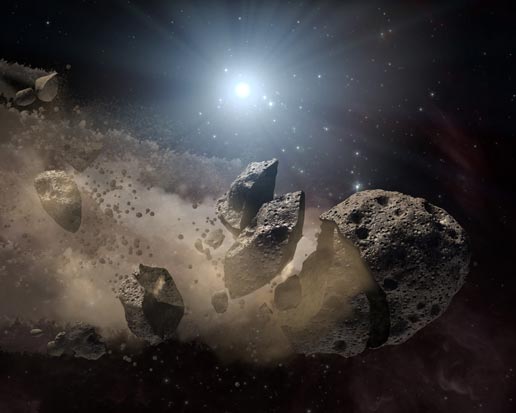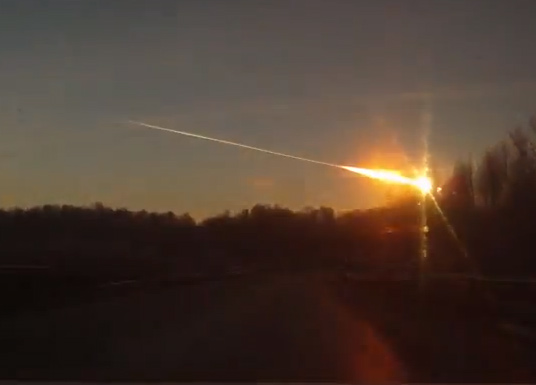
On February the 15th a 10,000 ton rock passed through Earth’s atmosphere, passed by the city of Chelyabinsk, Russia with a sound bang destroying windows and even making roofs collapsing – injuring over 1500 people – then hit the ground in an uninhabited area with a force equivalent to 440 kilotons of TNT (about 20–30 times more energy than was released from the atomic bombs detonated at Hiroshima and Nagasaki).
Now, according to some theoretical models, scientists have come up with an unsettling hypothesis —the Chelyabinsk asteroid was possibly not alone. The two brothers Carlos and Raúl de la Fuente Marcos at the Complutense University of Madrid have run exhaustive computer simulations of the Chelyabinsk asteroid orbit. The resulting paper has been accepted for publication in the journal Monthly Notices of the Royal Astronomical Society. In the paper, the two brothers present the possibility that they may have identified similar objects that could pose a risk.
What made the meteor that struck Russia so difficult to spot was the fact that it came from an angle masked by the glare of the Sun. A blind spot for astronomers trying to survey our skies for possible dangerous objects.
Chelyabinsk Cluster
The De la Fuente Marcos brothers built a mathematical model and compared it with known asteroid orbits from NASA’s databases. And based on this a remarkable scenario emerged. The brothers noticed that the Chelyabinsk asteroid may have originated from another shattered asteroid with pieces still out there orbiting in a cluster.
This is a bunch of space rocks named the “Chelyabinsk cluster”, consisting of about 20 objects between 5 and 200 meters in diameter. And the theory is that the Chelyabinsk meteor itself originated from a larger body that began to break up about 40,000 years ago.

If this is indeed correct, it implies that more meteors may be inbound for collisions with Earth. Since the largest asteroid in this cluster, the asteroid “2011 EO40” is approximately 200 meters across, the potential outcome of this rock colliding with Earth would be devastating.
2011 EO40
A 200-meter compact stony asteroid would impact the Earth with a Kinetic energy at atmospheric entry equal to 376 Mt (megaton TNT)a and its impact energy would be about 261 Mt, with a resulting crater being about 3 kilometers (1,9 miles) across.
In comparison, the biggest nuclear (fusion) bomb ever detonated was the Russian “Tsar Bomba” with it had a blast yield equal to 50 mt.
The 2011 EO40 asteroid’s orbit is very unpredictable since it passes close to Venus, Earth, and Mars – all affecting its trajectory. It is also continually and gradually scattering other smaller asteroids in the cluster, which is also affecting its trajectory.
Since the gravitational pull of these planets probably affects the path of each asteroid in the cluster in a slightly different way, the Chelyabinsk meteor would have been very difficult to track, even if it was seen much earlier and not hidden by the Sun.
Samples Provides the Answer
The evidence is however yet circumstantial and future observations are needed to affirm if the above scenario is indeed correct. And the only way to definitely confirm the origin of the Chelyabinsk meteor would be to compare samples of fragments of the Chelyabinsk meteorite and the 2011E040 asteroid.
Or a cheaper but less accurate way would be to gather high-resolution spectra of reflected light of these objects to possibly learn about their composition. Nevertheless, it is probably an idea to keep track of the Chelyabinsk cluster from now on.
________________
Monthly Notices of the Royal Astronomical Society
________________________________











![OpenAI. (2025). ChatGPT [Large language model]. https://chatgpt.com](https://www.illustratedcuriosity.com/files/media/55136/b1b0b614-5b72-486c-901d-ff244549d67a-350x260.webp)
![OpenAI. (2025). ChatGPT [Large language model]. https://chatgpt.com](https://www.illustratedcuriosity.com/files/media/55124/79bc18fa-f616-4951-856f-cc724ad5d497-350x260.webp)
![OpenAI. (2025). ChatGPT [Large language model]. https://chatgpt.com](https://www.illustratedcuriosity.com/files/media/55099/2638a982-b4de-4913-8a1c-1479df352bf3-350x260.webp)








